Mishing; The Water Man of Assam best understood from the river approach
‘Mi’—Man and ‘Asi’—Water gives rise to the name Mising or Mishing. Originally an eastern Himalayan tribe of Tibeto-Burman origin, ‘Tani’ people who descended along the river Brahmaputra to the welcoming weather conditions of the north-east. Miri or Mishing are now a major ethnic group, the second largest tribe in Assam.

The river Brahmaputra designs the life of those who live off its banks. Brahmaputra is a force born of snow melt and the monsoon carrying large volumes of alluvium from mineral rich young mountains and depositing in the lap of the flood plains, giving an opportunity to the populace to thrive the onslaught.
 The receding Brahmaputra opens vistas for agriculture and peace along the banks for the farmer to engage with the newly energised land and the artist to give flight to dreams and weave stories.
The receding Brahmaputra opens vistas for agriculture and peace along the banks for the farmer to engage with the newly energised land and the artist to give flight to dreams and weave stories.
Mishing, steeped in centuries of river experience have developed traditional ecological knowledge bank—their indigenous status in the middle and upper regions of the Brahmaputra has led to confidence to battle the water conditions of the roaring Brahmaputra.
 The annual devastation and loss of livelihood has made the Mishing extremely resilient to the vagaries of the unpredictable ‘moving ocean’. The post flood benevolence of fertile expanse makes the Mishing tribe develop faith that the river is a source of life and not a threat. They recognise that water, sky, and the woods are imbued with supernatural power and so it must be respected. The Mishing lead a fluid and temporary existence on the vast islands that Brahmaputra creates as its waters recede.
The annual devastation and loss of livelihood has made the Mishing extremely resilient to the vagaries of the unpredictable ‘moving ocean’. The post flood benevolence of fertile expanse makes the Mishing tribe develop faith that the river is a source of life and not a threat. They recognise that water, sky, and the woods are imbued with supernatural power and so it must be respected. The Mishing lead a fluid and temporary existence on the vast islands that Brahmaputra creates as its waters recede.

The Mishing have developed an understanding of the temperament of the river and with centuries of experience have learned to co-exist. They have engineered ingenious techniques to survive through the floods on their bamboo havens.
The Mishing pray to the Sun as mother (Donyi) and to the moon as father (Polo). They also worship their ancestors as the ancestors are considered as guardians. The dead are buried within their own land.
 These traditional wooden or Bamboo houses built on bamboo stilts with mud foundations and bamboo roofs, flooring and walls are called ‘Kare Okum’ in Mishing and ‘Chang Ghars’ in Assamese. These are raised at least 5 to 10 feet to adjust to the flood level each year. These are ‘I’ shaped, every new room is constructed behind the previous one, in a straight line.
These traditional wooden or Bamboo houses built on bamboo stilts with mud foundations and bamboo roofs, flooring and walls are called ‘Kare Okum’ in Mishing and ‘Chang Ghars’ in Assamese. These are raised at least 5 to 10 feet to adjust to the flood level each year. These are ‘I’ shaped, every new room is constructed behind the previous one, in a straight line.
 These Chang Ghars have interesting architecture with innovative features. The inside of the Chang Ghar is built in levels with a particular purpose. The first room after an open platform has a fireplace called ‘Merum’ and above this are two bamboo shelves tied to the roof with jute or cane rope. Fish and meat are spread on the shelf close to the fire so that the smoke from the fire can help preserve the meat. This shelf is called ‘Perub’ and ‘Rabbong’ on the next level is for storing meat and the home-brewed rice beer called ‘Apong’.
These Chang Ghars have interesting architecture with innovative features. The inside of the Chang Ghar is built in levels with a particular purpose. The first room after an open platform has a fireplace called ‘Merum’ and above this are two bamboo shelves tied to the roof with jute or cane rope. Fish and meat are spread on the shelf close to the fire so that the smoke from the fire can help preserve the meat. This shelf is called ‘Perub’ and ‘Rabbong’ on the next level is for storing meat and the home-brewed rice beer called ‘Apong’.
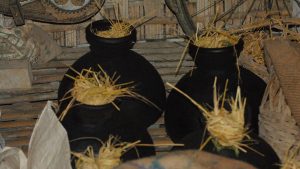 Apong is stored in clay pots. Kumbang’ is the shelf closest to the ceiling for storing home-grown potatoes, garlic, and onions. Apong is enjoyed with every meal. It is a way of life for both men and women. Apong is generally prepared by women and guests too are greeted with a drink of Apong. This country liquor is also served freely during mortuary rites and there are no taboos attached to alcohol among the Mishings.
Apong is stored in clay pots. Kumbang’ is the shelf closest to the ceiling for storing home-grown potatoes, garlic, and onions. Apong is enjoyed with every meal. It is a way of life for both men and women. Apong is generally prepared by women and guests too are greeted with a drink of Apong. This country liquor is also served freely during mortuary rites and there are no taboos attached to alcohol among the Mishings.
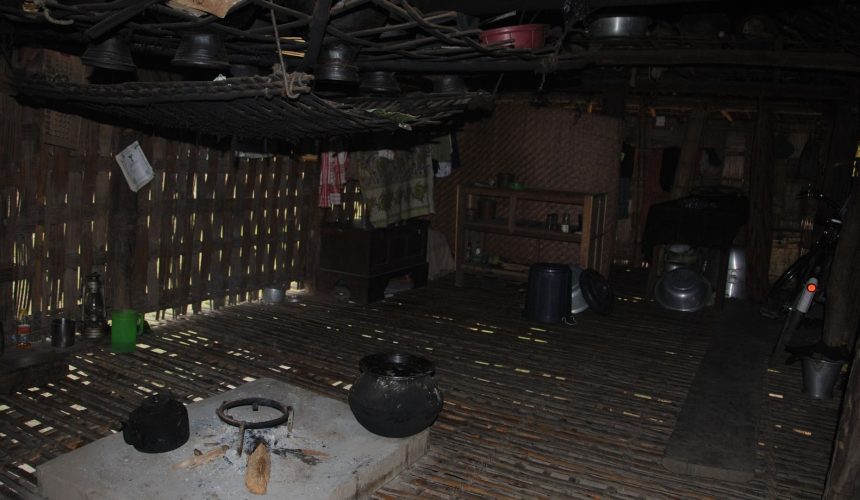 The open raised platform or front porch of this bamboo architecture is called ‘Tunggeng’. This is used for storing grains. One can reach the platform by a bamboo ladder or a wooden plank with foot-holds as wooden pieces. Each house has its animals under the stilts. The space below is also used for setting up a loom where the women can weave clothes for subsistence and as a commercial venture.
The open raised platform or front porch of this bamboo architecture is called ‘Tunggeng’. This is used for storing grains. One can reach the platform by a bamboo ladder or a wooden plank with foot-holds as wooden pieces. Each house has its animals under the stilts. The space below is also used for setting up a loom where the women can weave clothes for subsistence and as a commercial venture.
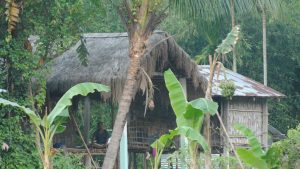 As the threat of floods looms in the air, the Mishing keep a wooden boat or ‘Ollung’ to sail away to safety or to go fishing. They also make banana trunk rafts.
As the threat of floods looms in the air, the Mishing keep a wooden boat or ‘Ollung’ to sail away to safety or to go fishing. They also make banana trunk rafts.
“The river Brahmaputra carves the life of a Mishing”
A typical Mishing village generally has certain key areas in the vicinity; a river or a pond that provides fish; a forest or ‘chapori’, which serves as a source for fruits, wood, firewood, herbs, etc, and a grazing land for the livestock/cattle to feed on. The existence of these areas enabled the Mishing community to have a self-sufficient life in earlier times.
The Mishing community has their own devotional songs called ‘A:bangs’ which are sung by the priest called ‘Mibu’. The society also enjoys its exquisite love songs called ‘oi:ni:toms’ that give a glimpse of the youth psychology. They prove that even the unlettered people can create superb imagery. They also throw light on social and domestic relations including their occupations and how lovers talk in them rather than in ordinary speech.
 The Mishing are a Patrilineal society and so the property is passed on from father to son.
The Mishing are a Patrilineal society and so the property is passed on from father to son.
 The Mishing believe the evil spirits bring trouble and ‘the good spirits’ are one’s ancestors who bless and bestow good fortune. These spirits exist forests, rivers, and the sky and can be ‘appeased’ at regular intervals, through various rituals and offerings. This approach takes centre-stage when the Mishings deal with floods, the community lays its focus on ‘preparedness’, which gets manifested in the living style of the Mishings.
The Mishing believe the evil spirits bring trouble and ‘the good spirits’ are one’s ancestors who bless and bestow good fortune. These spirits exist forests, rivers, and the sky and can be ‘appeased’ at regular intervals, through various rituals and offerings. This approach takes centre-stage when the Mishings deal with floods, the community lays its focus on ‘preparedness’, which gets manifested in the living style of the Mishings.
This attitude shows in paddy cultivation, farming fishing and storing of grains andalso in their architecture. The Mishing focus on ‘Lai aam’ which is rice cultivation in the dry season and is harvested before the floods. They also cultivate ‘Aamdang Arig’, wet paddy cultivation. This multi crop cultivation gives them stability.
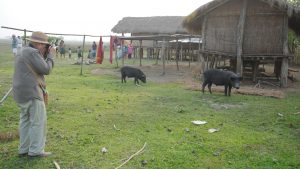 The Mishing take up a community activity of building a high raised platform called ‘Murong Okum’ as cattle shelter. If during floods any house gets inundated, the family can move to this higher platform temporarily.
The Mishing take up a community activity of building a high raised platform called ‘Murong Okum’ as cattle shelter. If during floods any house gets inundated, the family can move to this higher platform temporarily.
The best way to see the Mishing culture is to visit their villages on river islands. The story comes alive and their happy colourful welcoming nature shows through their eyes.

Best time to experience Assam’s Riverscapes:
The touring season starts with the arrival of migratory birds in October to enjoy the swamps and ends with the flying away of these winged creatures by the end of April when the swamps start flooding.
How can life along the river be accessed by a world traveller?
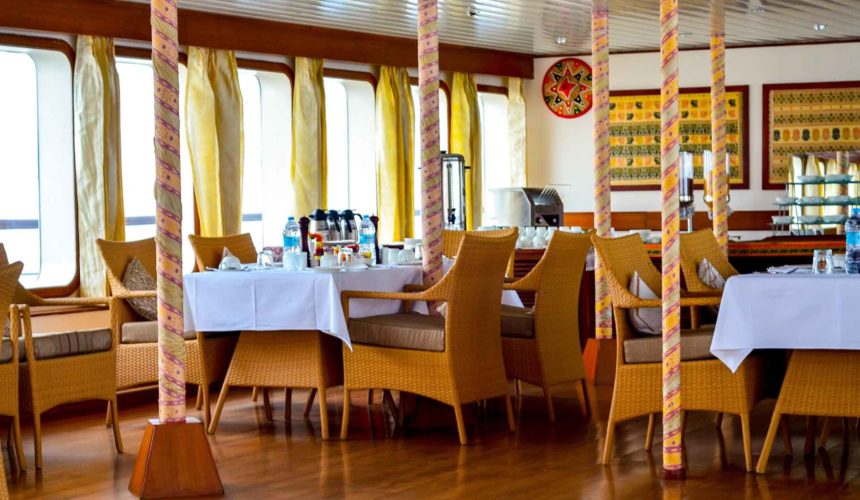
These riverscapes can be enjoyed best when the space of comfort transports you to the destination and offers unparalleled soft adventure and hands on interaction with the simplistic lifestyles of various tribes that have lived off the river.
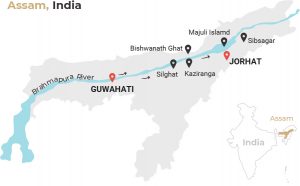 A 7 night Eight-Day Cruise on the Brahmaputra River on board, luxury vessel MV Mahabaahu offers a boutique experience. The river offers both the world’s smallest inhabited riverine island called the Peacock Island at one end of the cruise and at the other end the largest inhabited island, the Majuli Island. The 180 kilometre stretch from Guwahati to Silghat sees dotted small and large villages occupied by migrants from Bangladesh where women can be seen in sarees and men where checkered lungis and are of Muslim origin. The next stretch of 200 kilometres from Silghat to Neamati is dotted with ethnic Mishing tribals who are of Buddhist or of Vaishnav faith. Paddy, corn, sugarcane, peanuts, and vegetable farming along with weaving, pottery, boat making and fishing keeps this population busy on their seasonal sojourn on the mighty Brahmaputra.
A 7 night Eight-Day Cruise on the Brahmaputra River on board, luxury vessel MV Mahabaahu offers a boutique experience. The river offers both the world’s smallest inhabited riverine island called the Peacock Island at one end of the cruise and at the other end the largest inhabited island, the Majuli Island. The 180 kilometre stretch from Guwahati to Silghat sees dotted small and large villages occupied by migrants from Bangladesh where women can be seen in sarees and men where checkered lungis and are of Muslim origin. The next stretch of 200 kilometres from Silghat to Neamati is dotted with ethnic Mishing tribals who are of Buddhist or of Vaishnav faith. Paddy, corn, sugarcane, peanuts, and vegetable farming along with weaving, pottery, boat making and fishing keeps this population busy on their seasonal sojourn on the mighty Brahmaputra.
How does one experience the unique features of Assam?
The river unites the three fascinating cultures of the Tibetan Civilization in the North, the sleepy villages of India in Arunachal Pradesh and Assam Valley and the bustling villages in the Delta of Bangladesh. There’s more to this river in India’s northeast than just its annual floods. The river is revered equally by the religious canvas of indigenous populace of Hindus, Jains, Sikhs, Buddhists, Muslims and Bons.
MV Mahabaahu offers an expedition form of cruising on the mighty Brahmaputra that refuses to be tamed. MV Mahabaahu is a 23 cabin (2 suites, 2 Luxury Cabins and 7 Deluxe Cabins with private balconies and 12 Superior cabins with large picture windows.) motor vessel offering a seven-night eight-day rendezvous, Sunday to Sunday from October to April.
The 7 night Upstream itinerary from starts at Guwahati and ends in Jorhat in the State of Assam, while the 7 night Downstream itinerary starts from Jorhat to Guwahati in the State of Assam. Airport connectivity is available at Guwahati and Jorhat. All inclusive price starts from USD 350* per person per night for base category cabins.
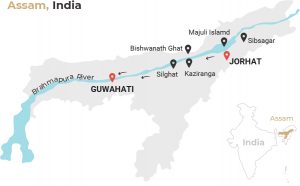 The Itinerary is subject to weather and river conditions or if we are faced with any political challenges. The tourism season is from October to April: In the coldest month of January, the temperatures range from 60-degree Fahrenheit to 70-degree Fahrenheit or 15-degree Celsius to 21-degree Celsius. Warm layering is required. Light rain can be expected so a parasol/mackintosh would be useful.
The Itinerary is subject to weather and river conditions or if we are faced with any political challenges. The tourism season is from October to April: In the coldest month of January, the temperatures range from 60-degree Fahrenheit to 70-degree Fahrenheit or 15-degree Celsius to 21-degree Celsius. Warm layering is required. Light rain can be expected so a parasol/mackintosh would be useful.
Binoculars and cameras will enhance the experience. Casual light comfortable clothes, comfortable walking shoes for all excursions, sun shades and hats are recommended. We organise Sit-down dinners at the end of the day. Breakfast and Lunch are buffet setting. Drinking Water systems are fitted in all cabins along with flasks for excursions. Tea/Coffee/cookies and hot water kettle facilities are available in each cabin. All items in the Minibar are chargeable. Laundry/Sauna/Steam/Jacuzzi/Ayurvedic therapies/Rejuvenation Massages/ Hair Spa facilities too are available on board.
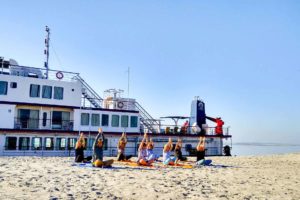 Yog practice on pristine deserted sandy islands and to stroll the soft silver carpet of sand and continue into numinous bonfire evening under the distant suns that twinkle in our night sky of the northern hemisphere. Barbequed snacks in ethnic tribal style, a local brew to wash down, some games to indulge in and a traditional reverence to the son of Brahma for a safe passage completes the enthralling journey
Yog practice on pristine deserted sandy islands and to stroll the soft silver carpet of sand and continue into numinous bonfire evening under the distant suns that twinkle in our night sky of the northern hemisphere. Barbequed snacks in ethnic tribal style, a local brew to wash down, some games to indulge in and a traditional reverence to the son of Brahma for a safe passage completes the enthralling journey
Cruise with Confidence: We’ve added fresh procedures to upraise our hygiene ideals for every facet of onboard practice; air filtration systems, personal steel flasks, cabin-based water filtration units and added hand sanitizer stations at all exits and entries. Immunity-enhancing herbal teas, Yoga and nature-walks, cruising in the lap of wilderness and enjoying beverages on silver sands of deserted islands away from civilization are conducive in times of pandemic or any other infection. Ayurvedic treatments, Steam Sauna, and Jacuzzi for rejuvenation and a Paramedic on board are an added advantage.
*Terms and conditions apply.


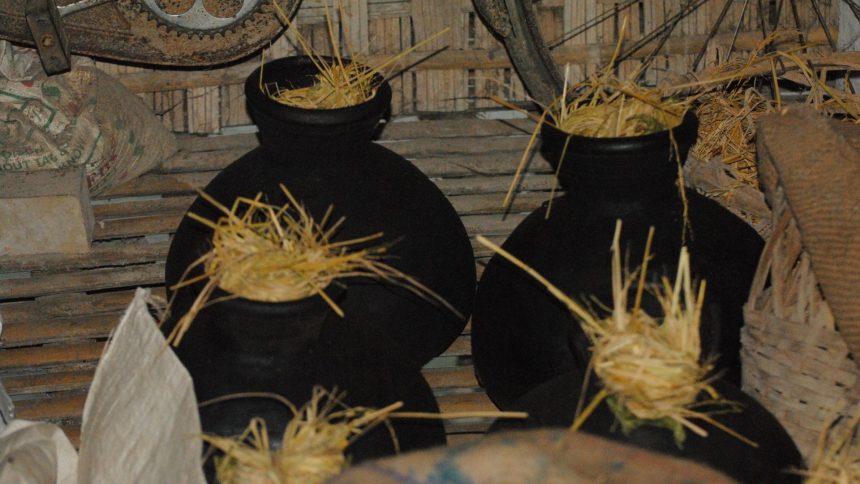











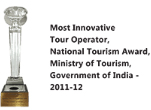

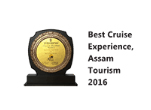


Leave a Reply
You must be logged in to post a comment.